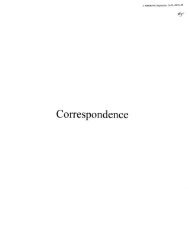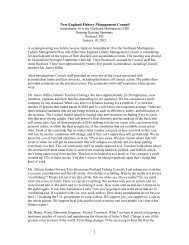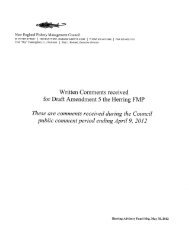Smooth Bottom Net Trawl Fishing Gear Effect on - New England ...
Smooth Bottom Net Trawl Fishing Gear Effect on - New England ...
Smooth Bottom Net Trawl Fishing Gear Effect on - New England ...
Create successful ePaper yourself
Turn your PDF publications into a flip-book with our unique Google optimized e-Paper software.
NOAA/NMFS Unallied Science Project, Cooperative Agreement NA16FL2264 December 2005<br />
<str<strong>on</strong>g>Smooth</str<strong>on</strong>g> <str<strong>on</strong>g>Bottom</str<strong>on</strong>g> <str<strong>on</strong>g>Net</str<strong>on</strong>g> <str<strong>on</strong>g>Trawl</str<strong>on</strong>g> <str<strong>on</strong>g>Fishing</str<strong>on</strong>g> <str<strong>on</strong>g>Gear</str<strong>on</strong>g> <str<strong>on</strong>g>Effect</str<strong>on</strong>g> <strong>on</strong> the Seabed:<br />
Investigati<strong>on</strong> of Temporal and Cumulative <str<strong>on</strong>g>Effect</str<strong>on</strong>g>s BKAM/CR<br />
comm<strong>on</strong>. The hemichordate, Phor<strong>on</strong>is, was am<strong>on</strong>g the dominant prey for yellowtail.<br />
Three groups of amphipods (caprellids, phoxocephalids and ampeliscids) were important<br />
food items at Mud Hole for blackbacks. At Little Tow aroids were again am<strong>on</strong>g the<br />
dominant prey.<br />
November stomach c<strong>on</strong>tents were dominated by spi<strong>on</strong>ids except for blackback flounder<br />
from Little Tow. The average number of organisms found was 47.4 to 443.6. Numbers<br />
of species present ranged from 9.0 to 25.7. Cerianthid anem<strong>on</strong>es were the most comm<strong>on</strong><br />
prey for blackbacks at this site and in many cases stomachs were filled with a few large<br />
individuals of Cerianthus, leaving little room for anything else. Additi<strong>on</strong>al comm<strong>on</strong> prey<br />
items were ampharetids, cirratulids and phor<strong>on</strong>ids. Cerianthids, which can grow to a<br />
large size were almost absent in the diet for yellowtail, which have smaller mouths.<br />
There was fairly good comparis<strong>on</strong> between the species listed as dominants in the benthic<br />
grab samples and those found in the stomachs of flounders. Spi<strong>on</strong>ids were abundant in<br />
both cases. Phor<strong>on</strong>ids were more abundant in October and November benthic sampling<br />
events and they became more comm<strong>on</strong> am<strong>on</strong>g the prey items. There are other taxa for<br />
which there seem to have been some selectivity because they were found am<strong>on</strong>g the<br />
dominant comp<strong>on</strong>ents of the stomachs but not in the grab samples. Some of these species<br />
might have been present in good numbers in grab samples but their relative numerical<br />
dominance was greater in fish stomachs. Such taxa include flabelligerids and<br />
lumbrinerieds (polychaetes). Others, with low densities in infaunal samples, were am<strong>on</strong>g<br />
the dominants in stomach analyses; e.g. caprellids, aorids, ampeliscids and<br />
phoxocephalids am<strong>on</strong>g the amphipods, and the anem<strong>on</strong>e Cerianthus.<br />
The total number of individuals (abundance) and numbers of species (richness) found in<br />
yellowtail and blackback stomachs were compared (Table 3.6-9) and tested for<br />
significant differences. With the excepti<strong>on</strong> of the August survey when very little material<br />
was found in any of the stomachs, the number of organisms found in yellowtail stomachs<br />
was significantly higher than found in blackbacks. Species richness was also<br />
significantly higher in yellowtail stomachs than in blackbacks except in August.<br />
Yellowtail with their small mouths, apparently select smaller, more abundant organisms<br />
as their food supply, and a wider variety of species. Blackback flounder are able to select<br />
larger, less abundant species as a significant comp<strong>on</strong>ent of their diet. They do however<br />
also c<strong>on</strong>sume many of the small polychaetes that are the staple of the yellowtail diet.<br />
61







